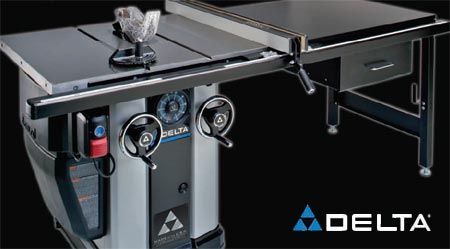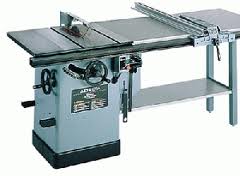
Using a Table Saw Safely
The table saw is probably the biggest staple of any worthy workshop or job site.
Most table saw safety problems can be avoided by knowing how to safely operate the saw, using common sense and avoiding certain practices.
Here are a few safety concerns to consider when using a table saw:
CLOTHING
Avoid gloves while operating. Gripping power is lost to gloves and some kinds of gloves are loose enough to present an item for the rotating blade to grab and pull into the blade.
Roll up your sleeves or Wear short sleeves. Loose-fitting clothing and jewelry should be avoided while operating a table saw. Any of these items might get caught in the blade and pull you into the blade.
Wear proper eye and hearing protection. Eyes need to be protected from damage by projectiles.
Always wear footwear with non-slip soles.
BODY POSITIONING | CORE STRENGTH
KEEP A CLEAN SHOP FLOOR
Keep the floor in front of the saw free of cut-offs and piled up sawdust. Tripping, falling or sliding into a running saw blade can result from sawdust and debris.
USING THE SAW
Use a push stick to cut narrow stock. A hand that isn’t close to a blade isn’t going to get cut. Generally, a 4” to 6” minimum distance to the blade is considered safe. I prefer using a narrow push stick like the Bench Dog Pocket Push Stick. [photo right]
Use a stop block when you crosscut short lengths. Mount a stop block on the fence to avoid the cut-off piece from binding between blade and fence. A stop block can be a board clamped to the fence that stops just before the saw blade,
Never reach behind or over the blade unless it has stopped turning.
Get in the habit of disconnecting the power before changing the blade or performing any other maintenance operation.
Keep the tabletop clear of tools, fasteners and debris. A rusty, dirty or rough table requires you to use more force to push the stock through the blade. Tools, accessories or fasteners is left on the tabletop could accidentally be pushed into the moving blade causing a projectile. Check to make sure the blade is clear to spin and nothing is touching the blade before turning the saw on.
Avoid free-hand cuts on a table saw. Guide the stock through the blade using the rip fence or the miter gauge.
Push the wood all the way past the blade. Releasing work too early is an invitation to kickback.
Check stock before cutting. Look for nails, knots, screws, or stones which can become projectiles causing serious injury as well as can damage the saw blade.
SAW ADJUSTMENTS
Keep the blade guards, splitters and anti-kickback fingers in place and operating freely. Check the action of these items before starting work.
Keep the rip fence parallel to the blade so stock doesn’t bind on the blade and kick back. Many woodworkers adjust the rear of the fence out of parallel and away from the front fence position by 1/64″.
Use zero clearance inserts. These reduce the chance of slender cuts dropping into the lower part of the blade and becoming a projectile and they also reduce splintering in cuts.

